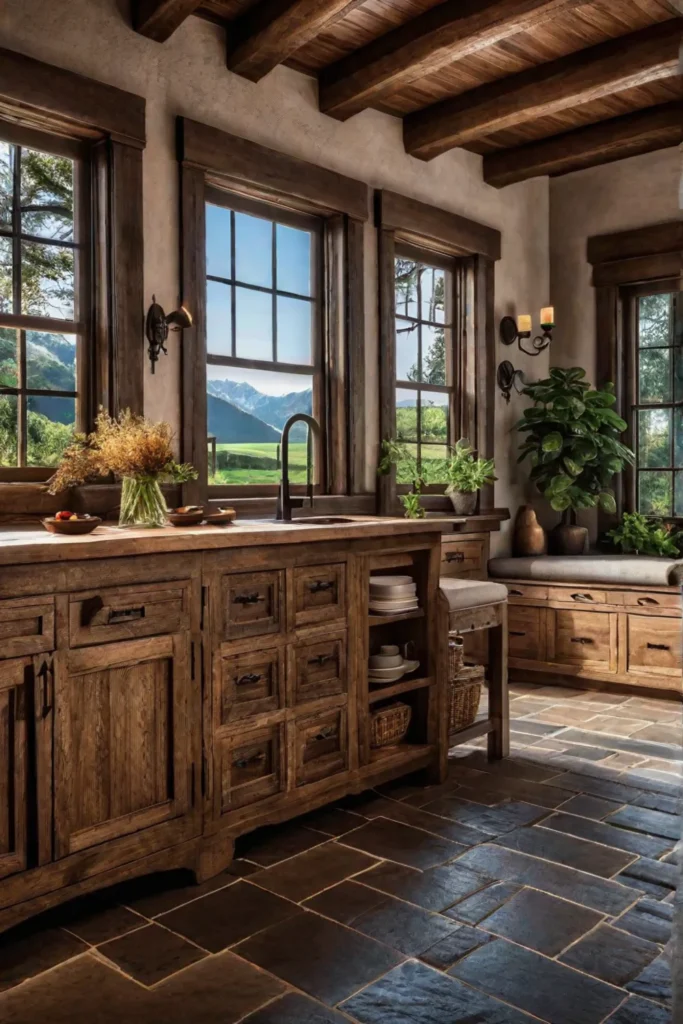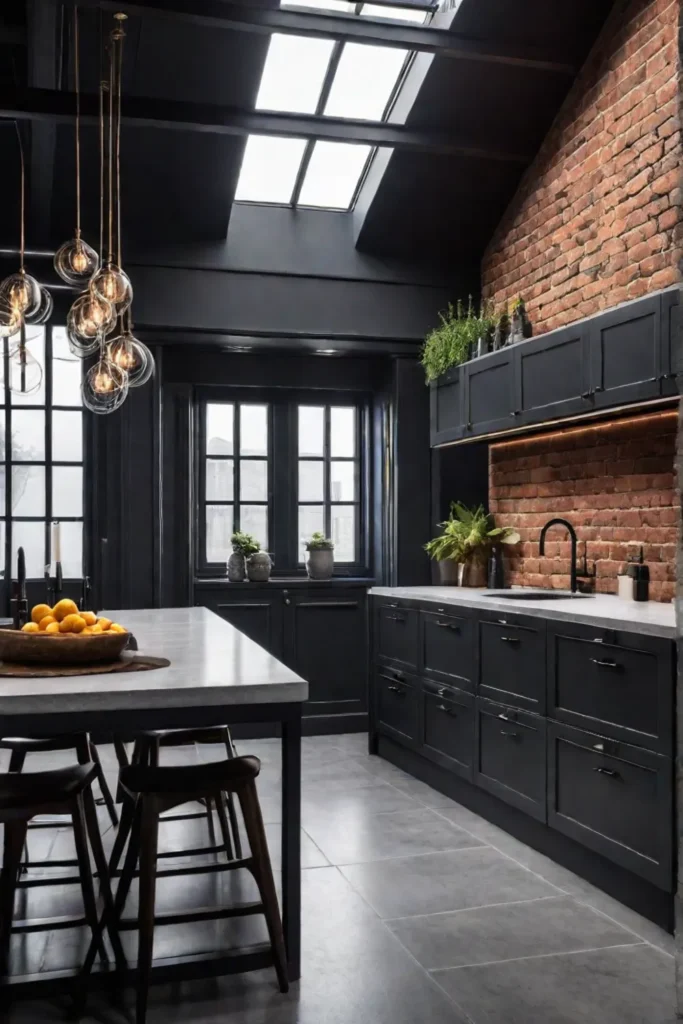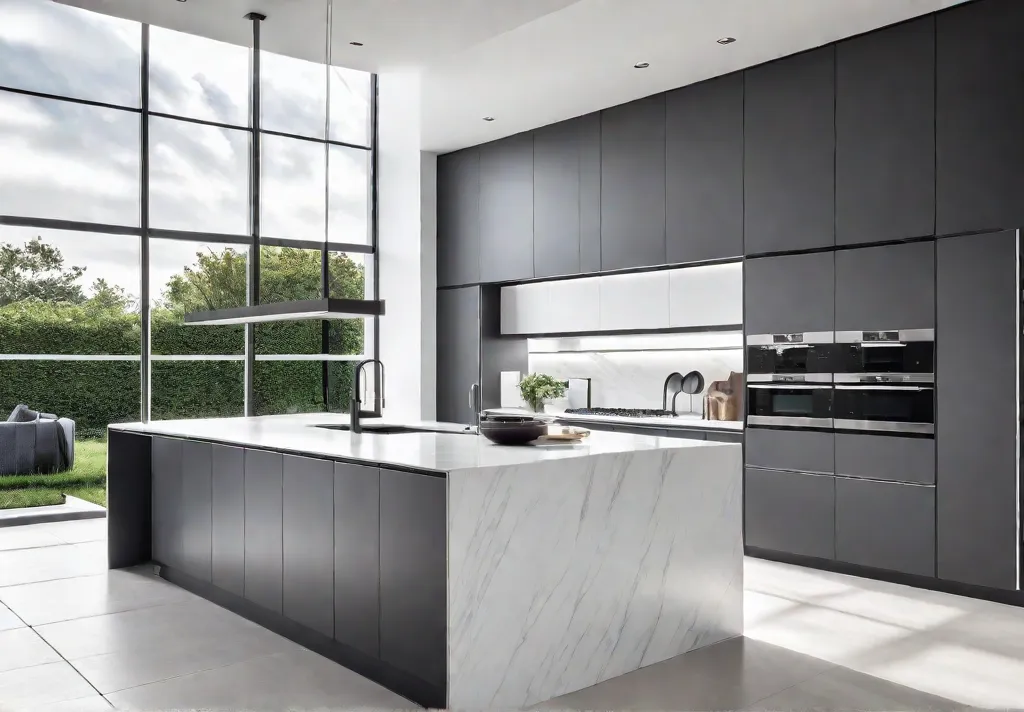Can you imagine your dream kitchen? Sleek countertops, gleaming appliances, and…a stunning floor that ties the whole space together. The floor may seem like an afterthought, but it plays a crucial role in setting the tone for your kitchen’s overall aesthetic. That’s why selecting the right tiles is a decision you don’t want to take lightly.

So, let’s dive into kitchen floor tiles and explore the pros and cons of three popular options: porcelain, ceramic, and natural stone. By the end of this guide, you’ll be armed with the knowledge to make an informed choice that aligns with your personal style, budget, and practical needs.
Porcelain Tiles: Strength and Sophistication
When it comes to kitchen floors, durability is a top priority. After all, this is a high-traffic area that sees its fair share of spills, dropped utensils, and heavy foot traffic. Enter porcelain tiles – the superheroes of the tile world.

Crafted from a blend of clay, feldspar, and quartz, porcelain tiles are renowned for their exceptional strength and density. They are often rated as the most scratch-resistant and slip-resistant option, making them ideal for busy kitchens.
But porcelain tiles aren’t just about brawn; they also boast beauty. With a wide range of styles, colors, and finishes, you can create a look that seamlessly complements your kitchen’s aesthetic. The possibilities are endless, from classic marble-inspired designs to modern, large-format tiles.
Imagine a sleek, contemporary kitchen adorned with charcoal-hued porcelain tiles that mimic the rich veining of natural stone. Or envision a cozy, farmhouse-inspired space grounded by warm, wood-look porcelain planks. The versatility of porcelain tiles allows you to effortlessly achieve your desired ambiance.
Maintaining porcelain tiles is also a breeze. Their dense composition makes them resistant to staining and water damage, so you can bid farewell to endless scrubbing and worry. A regular sweep and occasional damp mopping are all it takes to keep your floors looking pristine.

While porcelain tiles may have a higher upfront cost than other options, their durability and low maintenance requirements can translate to long-term cost savings. Plus, with proper installation by a professional, these tiles can withstand the test of time, ensuring your investment lasts for years.
Ceramic Tiles: Affordable Elegance
If you’re working with a tighter budget, ceramic tiles might be the perfect solution for your kitchen floor. Don’t let their affordability fool you, though – these tiles pack a punch in style and practicality.

Crafted from natural clay fired at high temperatures, ceramic tiles offer a durable and long-lasting surface that can withstand a busy kitchen’s daily wear and tear. While not as waterproof as porcelain, ceramic tiles still hold their own when resisting stains and moisture absorption.
One of the biggest draws of ceramic tiles is their vast array of design options. From vibrant, hand-painted patterns to textured, rustic finishes, these tiles infuse your kitchen with personality and character. Imagine a Mediterranean-inspired space adorned with intricate, terracotta-hued ceramic tiles or a modern, minimalist kitchen grounded by sleek, monochromatic tiles.
Installation is another area where ceramic tiles shine. Compared to other materials, they are generally easier to work with, making them a more DIY-friendly option for kitchen renovations. However, proper subfloor preparation and sealing are crucial to ensure long-term performance.

While ceramic tiles may require slightly more maintenance than porcelain, regular cleaning and occasional resealing can keep them looking their best for years. And with their budget-friendly price point, you can achieve a stunning kitchen floor without breaking the bank.
Natural Stone Tiles: Timeless Luxury
Natural stone tiles might be the perfect fit if you’re seeking a touch of timeless luxury for your kitchen. From the rich veining of marble to the earthy tones of slate, these tiles bring a sense of organic beauty and sophistication to any space.
One of the most captivating aspects of natural stone tiles is their uniqueness. Formed over millions of years by geological processes, each tile boasts distinct patterns and colorations, ensuring your kitchen floor is truly unique.

Imagine a warm, inviting kitchen adorned with tumbled travertine tiles, their soft hues, and textured surfaces, adding depth and character to the space. Or, envision a sleek, contemporary kitchen elevated by the dramatic veining of black marble tiles, exuding an air of elegance and sophistication.
While natural stone tiles undoubtedly add a luxurious touch, they offer exceptional durability and longevity. With proper sealing and maintenance, these tiles can withstand the rigors of a busy kitchen for decades, ensuring your investment stands the test of time.
However, it’s important to note that natural stone tiles require more specialized care than their porcelain or ceramic counterparts. Certain types of stone, like marble, can be susceptible to etching and staining from acidic substances commonly found in kitchen environments. Regular sealing and using pH-neutral cleaners are essential to preserving the beauty of your natural stone tiles.
Additionally, the installation process for natural stone tiles can be more complex, as the tiles may vary in thickness and require precise leveling to ensure a smooth, even surface. Professional installation is often recommended to provide a high-quality, long-lasting result.

While natural stone tiles may come with a higher price tag, their timeless appeal and ability to elevate the overall aesthetic of your kitchen can make the investment worthwhile for those seeking a truly luxurious and unique space.
The Cost Breakdown: Finding the Right Balance
Regarding kitchen floor tiles, cost is often a significant factor in decision-making. Let’s break down the average cost per square foot for each material to help you plan your budget:
- Porcelain tiles: $3 to $10 per square foot
- Ceramic tiles: $1 to $5 per square foot
- Natural stone tiles: $5 to $20 per square foot (or even higher for rare or exotic varieties)

Remember that these ranges are just a starting point, as the cost can vary significantly based on factors such as tile quality, size, and design complexity. Additionally, installation costs can substantially add to your overall budget, with porcelain and natural stone tiles typically requiring more specialized labor.
While porcelain tiles may have the highest upfront cost, their exceptional durability and low maintenance requirements can translate to long-term cost savings. On the other hand, ceramic tiles offer a more budget-friendly option but may require more frequent maintenance and potential replacements down the line.
While undoubtedly luxurious, natural stone tiles can be the most expensive option. Higher installation costs and specialized maintenance requirements add to the overall investment.

When planning your kitchen floor tile project, consider the upfront costs, long-term maintenance costs, and potential replacement costs over the floor’s lifetime. By weighing these factors carefully, you can make an informed decision that maximizes value and cost-effectiveness while aligning with your design vision and practical needs.
Maintaining Timeless Beauty: Durability and Care
While the initial installation is crucial, maintaining the appearance and longevity of your kitchen floor tiles is equally important. Each tile material has its unique maintenance requirements and durability considerations:

Porcelain Tiles: Renowned for their resistance to scratches, stains, and water damage, porcelain tiles are often hailed as the most durable and low-maintenance option for kitchen floors. Regular sweeping and occasional damp mopping with a pH-neutral cleaner are typically all needed to keep these tiles pristine.
Ceramic Tiles: While durable, ceramic tiles are more porous than porcelain, making them more susceptible to staining and water absorption over time. Regular cleaning and periodic sealing can help prevent these issues and extend the life of your ceramic tile floor.
Natural Stone Tiles: The beauty of natural stone tiles comes with a caveat – they can be more prone to etching, staining, and damage from acidic substances commonly found in kitchen environments. Specialized care, such as using pH-neutral cleaners and regularly resealing the tiles, is essential to preserving their timeless appeal.

Regardless of the tile material, addressing any maintenance issues promptly is important. Spills should be cleaned immediately to prevent staining, and any cracks or chips should be repaired to avoid further damage.
By maintaining regular cleaning and maintenance, you can ensure your kitchen floor tiles remain a stunning focal point for years to come, enhancing the overall aesthetic and functionality of your space.
Design Inspiration: Bringing Your Vision to Life
The design possibilities for kitchen floor tiles are truly endless. Each tile material offers unique aesthetic appeal, allowing you to create a space that reflects your style and vision.
Porcelain tiles are a versatile canvas, ranging from classic marble-inspired designs to modern, large-format tiles that create a seamless, minimalist look. You can even find porcelain tiles that mimic the warmth and texture of wood planks, offering a fresh twist on traditional hardwood floors.

Ceramic tiles, on the other hand, offer a world of vibrant colors, intricate patterns, and textured finishes. From hand-painted Mediterranean-inspired tiles to rustic, terracotta-hued options, these tiles allow you to infuse your kitchen with character and personality.
Natural stone tiles are the ultimate choice for those seeking a touch of timeless luxury. The unique veining and coloration of materials like marble, granite, and slate add depth and sophistication to any space, creating a distinctive focal point.
When selecting your kitchen floor tiles, consider not just the material but also the colors, patterns, and finishes that complement the overall design aesthetic you’re aiming for. Whether you’re going for a sleek, contemporary look or a warm, rustic vibe, the right tiles can harmoniously tie the entire space together.

Remember, your kitchen floor is more than just a functional surface – it’s an opportunity to express your style and create a space that truly feels your own. With the right tiles and a little creative vision, you can transform your kitchen into a stunning, inviting oasis you’ll love for years.
Installation Insights: Ensuring a Flawless Finish
While selecting the perfect tiles is crucial, proper installation is equally important to ensure a long-lasting, beautiful result. Each tile material comes with its unique installation considerations:
Porcelain Tiles: Due to their density and hardness, they often require specialized installation techniques and tools. These tiles can be more prone to cracking or chipping during installation, making it essential to work with experienced professionals who understand the nuances of porcelain tile installation.

Ceramic Tiles: While generally easier to install than porcelain, ceramic tiles require proper subfloor preparation and attention to detail. Ensuring a stable surface and using the appropriate thin-set and grout are crucial for a successful ceramic tile installation.
Natural Stone Tiles: The installation process for natural stone tiles can be complex, as these tiles often vary in thickness and require precise leveling to ensure a smooth, even surface. Additionally, certain types of natural stone may require specialized sealants or treatments during installation to protect against staining and moisture damage.
Regardless of the tile material you choose, proper preparation is key. This may include leveling the subfloor, addressing moisture issues, and ensuring the surface is clean and debris-free. Working with experienced tile installers can make all the difference in achieving a high-quality, long-lasting result.

For those considering a DIY installation, it’s important to thoroughly research the specific requirements and techniques for your chosen tile material. While ceramic tiles may be more DIY-friendly, porcelain and natural stone tiles often require more expertise and specialized tools.
By understanding the unique installation considerations for your kitchen floor tiles and working with skilled professionals (or tackling the project yourself with proper preparation), you can ensure a flawless finish that looks stunning and stands the test of time.
Conclusion: A Kitchen Floor That Tells Your Story
As you embark on your kitchen renovation journey, remember that the floor you choose will be a canvas for your style and reflect your unique story. Whether you opt for the durability and versatility of porcelain tiles, the affordable elegance of ceramic options, or the timeless luxury of natural stone, your kitchen floor can transform the space and create a lasting impression.

Imagine hosting a vibrant dinner party, your guests marveling at the intricate, hand-painted ceramic tiles that add a touch of Mediterranean flair to your kitchen. Or envision yourself sipping a morning coffee, basking in the warmth and organic beauty of your natural stone floor, each tile a unique work of art crafted by nature.
Your kitchen is more than just a functional space – it’s a canvas for creating memories, sharing stories, and celebrating the joy of life. By selecting the perfect tiles and embracing your design vision, you can craft a kitchen that truly feels like home, a space that reflects your unique journey and inspires countless cherished moments for years to come.
So, embrace the adventure of choosing your kitchen floor tiles, and let your imagination soar. After all, as Maya Angelou so eloquently said, “Life is not measured by the number of breaths we take, but by the moments that take our breath away.” May your kitchen floor be a constant source of breathtaking beauty and inspiration, a testament to the power of design to elevate the everyday and create a space that truly resonates with your soul.






